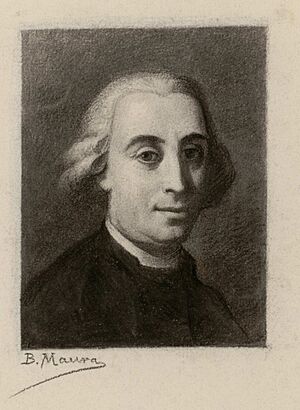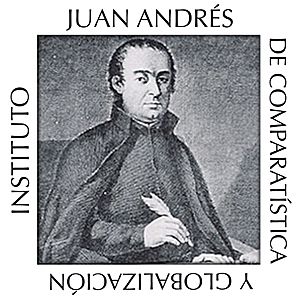Spanish Universalist School of the 18th century facts for kids
The Spanish Universalist School of the 18th century was a big project in science and humanities. It brought together old ideas from classical humanism with new scientific discoveries. This school also helped develop modern ways of comparing different studies. It was a unique part of the Enlightenment, mixing human sciences with natural sciences. This school changed how people saw European culture.
This group of thinkers had two main goals: to understand human culture and to explore empirical science (science based on observation). They helped create a global culture, especially after the School of Salamanca. Many of their ideas grew in northern Italy. One of the school's most important influences in the English-speaking world was Juan Andrés on the writer Henry Hallam.
Contents
Key Thinkers and Their Ideas
The idea of the "Spanish Universalist School of the 18th century" mainly focuses on three key figures: Juan Andrés, Lorenzo Hervás, and Antonio Eximeno. These three were Jesuit scholars who were expelled from Spain in 1767. Their major works helped create the first universal and comparative studies of sciences, arts, languages, and music.
However, the school actually included about 30 authors. They covered many different areas of knowledge. Some important members were:
- Miguel Casiri, a librarian.
- Antonio José Cavanilles, a naturalist.
- José Celestino Mutis, who led a plant expedition in South America.
- Juan Ignacio Molina from Chile.
- Francisco Javier Clavijero from Mexico.
- Other scholars from places like the Philippines and Argentina.
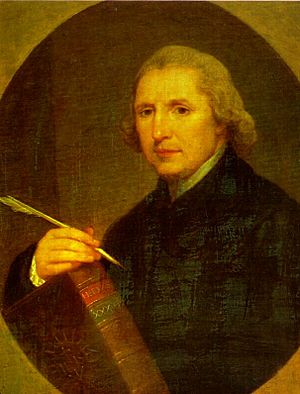
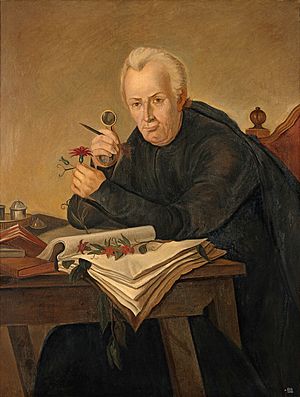
The Universalist School wanted to combine modern scientific methods (based on observation) with older humanistic traditions. This combination led to the "comparative method." This method helped them study history and science in new ways. They also believed in the importance of education and knowledge, especially by studying classical and modern languages.
Juan Andrés wrote a "Universal History of Arts and Sciences." Lorenzo Hervás created a system for understanding all languages, called "universal and comparative linguistics." Antonio Eximeno explored the idea of music in a new way, focusing on "expression."
An amazing example of their work is how Juan Andrés and Lorenzo Hervás studied and improved the language of the deaf, also known as sign language. They brought back a Spanish tradition that had started with Pedro Ponce de León in the 16th century.
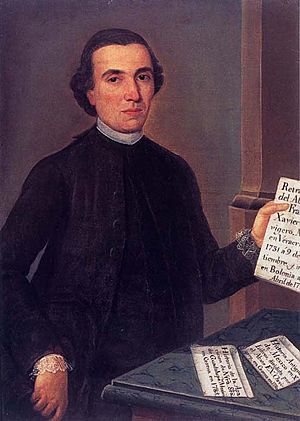
The Universalist School's global ideas came from the Enlightenment. This was a time when new ways of thinking became popular. However, their Enlightenment was more about science and history than about politics. The 18th century in Spain has often been overlooked by historians. But the Enlightenment was very important for shaping modern thought, both in politics and science.
It's important to know that there wasn't just one "Enlightenment." There was:
- Scottish and English empiricism (learning from experience).
- French encyclopedism (collecting all knowledge).
- German idealism (focusing on ideas and reason).
- The Spanish or Hispanic Enlightenment, which combined science, humanism, and a focus on history. This was different from the French encyclopedias.
Remembering Their Work
In 2017, people celebrated 200 years since the death of Juan Andrés (1740-1817). The "Instituto Juan Andrés de Comparatística y Globalización" organized many events.
One big event was a special book exhibition. It was held at the "Biblioteca Histórica Marqués de Valdecilla" in Madrid. This exhibition showed many of the important works from the Spanish Universalist School. It helped people see how important and powerful this group of thinkers was, even though they were not always recognized.
During this time, a never-before-seen manuscript by Juan Andrés was also released. It was called Furia. Disertación sobre una inscripción romana. This helped people understand more about his work in history and literature.
The celebrations, known as "Año Juan Andrés" (Juan Andrés Year), included many academic activities. They also published more of his writings and gave out an award for human sciences. These events continued in Italy, at places like the "Accademia Nazionale di Mantova" and the "Biblioteca Nazionale di Napoli." The celebrations ended with another exhibition in Madrid, which later became a book called "La Ilustración Hispánica."
Important Books from the Universalist School
Here are some of the most important works by the thinkers of the Spanish Universalist School:
- Juan Andrés (1773), Prospectus philosophiae universae. This was a philosophical work.
- Juan Andrés (1782-1799), Origen, progresos y estado actual de toda la literatura. This book explored the history and development of all literature.
- Juan Andrés (1786-1800), Cartas familiares (Viaje de Italia). These were personal letters about his travels in Italy.
- Juan Andrés, La Biblioteca Real de Nápoles. This book was about the Royal Library of Naples.
- Lorenzo Hervás, Idea dell'Universo, Cesena, 1778-1792, 21 vols. This huge work explored the "Idea of the Universe."
- Lorenzo Hervás (1785, 1800-1805), Catálogo de las lenguas de las naciones conocidas. This catalog listed and described languages from around the world.
- Lorenzo Hervás, Escuela Española de Sordomudos. This book was about teaching deaf people and sign language.
- Antonio Eximeno (1774), Del Origen y reglas de la Música. This work discussed the origins and rules of music.
- Antonio Eximeno (1789), De la Institución de los Estudios Filosóficos y Matemáticos. This book was about how to study philosophy and mathematics.
- Francisco Javier Clavijero, Historia Antigua de México. This book told the ancient history of Mexico.
- Juan Ignacio Molina, Saggio sulla storia naturale del Chili. This was an essay on the natural history of Chile.
- José Celestino Mutis, Flora de la Real Expedición Botánica del Nuevo Reino de Granada: 1783-1816. This massive work documented the plants found during a royal botanical expedition in New Granada (now Colombia).
- Antonio José Cavanilles, Géneros y especies de plantas demostradas en las lecciones públicas del año 1802. This book showed different types of plants.
See also
 In Spanish: Escuela Universalista Española del siglo XVIII para niños
In Spanish: Escuela Universalista Española del siglo XVIII para niños


